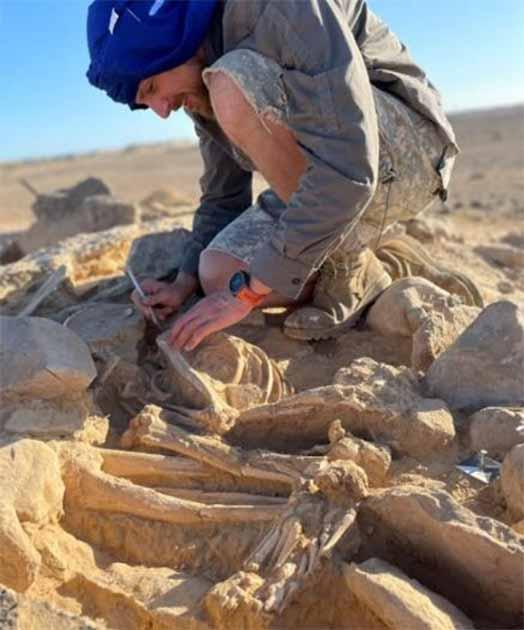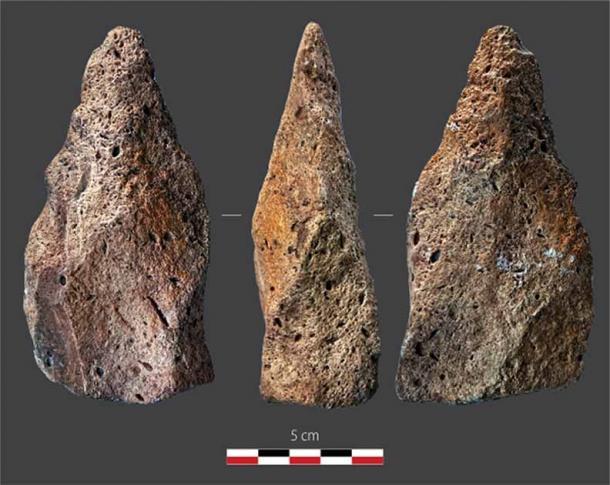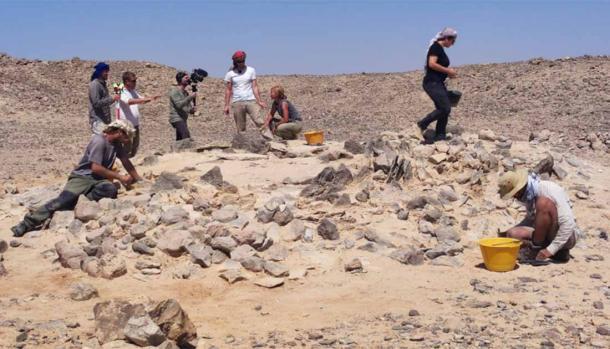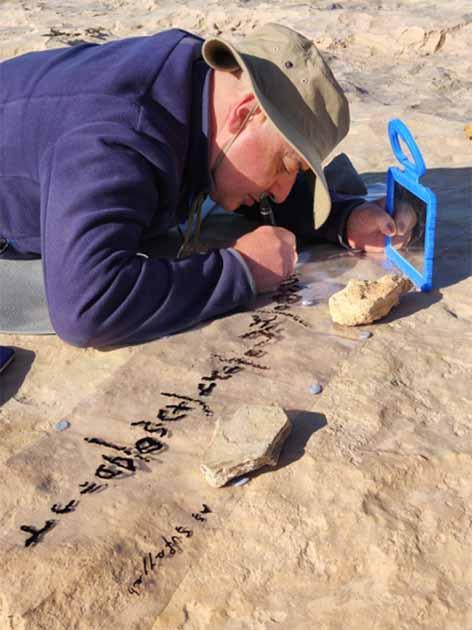
In the deserts of Oman, two teams of scientists have made remarkable discoveries that shed new light on the earliest history of human civilization. From rare hand axes dating back to the first waves of human migration out of Africa to circular burial chambers and a collection of rock engravings, these findings offer a glimpse into the formation of contemporary society in Southern Arabia.
More than twenty archaeologists and geologists from ten countries, led by the Institute of Archaeology of the CAS in Prague, have completed their third consecutive season excavating two archaeological sites in Oman.
The excavators found a collection of rare hand axes dating to the first waves of human migration out of Africa , circular burial chambers, and a collection of rock engravings. It is thought these finds, which were made in the world’s largest sand desert, will contribute to the understanding of the earliest history of what is today Oman.

Excavating burials at a site in Oman. (Roman Garba and Alžběta Danielisov/ Institute of Archaeology of the CAS in Prague )
A report in AVCR says last year’s work at two different sites in Oman represented the third excavation season in a row. This research is part of a greater archaeological project being led by Viktor Černý, an evolutionary anthropologist from the Institute of Archaeology in Prague, which focuses on “biocultural interactions of populations and their adaptation to climate change”.
One team excavated in the Dhofar Governorate, in the south of Oman, while the second group operated in the Duqm province, in central Oman. And broadcasting their work to the world, the two teams of researchers shared their findings on the @Arduq_Arabia Twitter account.
The Rub’ al Khali desert, in Oman’s Dhofar province, is known as the “Empty Quarter.” This sparsely populated region represents the largest contiguous sand desert in the world, spanning over 250,000 square miles in the Arabian Peninsula . Among sand dunes towering as high as 300 meters (984 ft), the archaeologists also found a fossilized dune, and an old riverbed from a period when the climate in Arabia was significantly wetter.
At this location, not only did the team of archaeologists discover eggshells from an extinct ostrich species, but they also unearthed a collection of stone hand axes. Dating later determined that these tools were made and used by some of the first humans to have migrated out of Africa, some 300,000 years ago.

Hand axes from at leasev300000 years ago were found at the site. (Roman Garba and Alžběta Danielisov/ Institute of Archaeology of the CAS in Prague )
Expedition leader, Roman Garba, from the Institute of Archaeology of the CAS in Prague, told LiveScience that these findings are hoped to provide valuable data for reconstructing ancient climates in the world’s largest sand desert. Furthermore, by understanding the natural conditions that shaped prehistoric settlements, the researchers will achieve a better idea “human adaptability to climate change,” which conforms with the goals set out by Professor Viktor Černý.
Garba explained that “nuclear physics” is being applied to this research project to help date the age of the finds. Garba said the Nuclear Physics Institute of the CAS have carried out radiocarbon dating and “cosmogenic radionuclide dating” on the finds, using “the first accelerator mass spectrometer in the Czech Republic.” Cosmogenic radionuclide dating is used to estimate the age of geological materials by measuring the concentration of isotopes created by cosmic rays. This method can accurately date rocks, and sediments on the Earth’s surface, and is used to assess historic changes in climate and tectonics.
Radiocarbon dating, and spatio-temporal analysis, helped the researchers learn more about ritual stone monuments , known as triliths, that are found across southern Arabia. Dating to about two-thousand-year-ago, Garba likened these circular burial structures to “a smaller-scale version of England’s better-known Stonehenge.” However, currently, it is not clear who built them, and what they were used for. Furthermore, Garba says nobody is sure “what is hidden beneath these burial chambers”?

Archaeologists examine a stone monument, known as a trilith. (Roman Garba and Alžběta Danielisov/ Institute of Archaeology of the CAS in Prague )
The second expedition team focused their work on a Neolithic tomb at the Nafūn site, near the town of Ibri, in the Duqm province of central Oman, along the Arabian Sea. Constructed between 5,000–4,600 BC this site contained the remains of a large, fortified settlement that dates back to the 3rd millennium BC, that later became an important trading center during the Bronze Age .
Professor Alžběta Danielisová, from the Institute of Archaeology in Prague, said the second team identified “a megalithic structure concealing two circular burial chambers,” in which the skeletal remains of several dozen individuals were recovered. Danielisová thinks Isotopic analyses of bones, teeth, and shells, will inform about “the diet, natural environment, and migrations of the buried population.” The researcher described these discoveries as “unique in the context of the whole of southern Arabia.”

An archaeologist traces one of the inscriptions found on a rock. ( Roman Garba and Alžběta Danielisov/ Institute of Archaeology of the CAS in Prague )
Not far from the 7,000-year-old circular tomb, team two also investigated stone tool production sites dating to the Late Stone Age, including a collection of rock engravings. Also described as “unique,” the scientists found over “49 rock blocks” of different styles and varying degrees of weathering which provide “a pictorial record” of life at this site, between 5,000 BC to 1,000 AD.
Viktor Černý from the Institute of Archaeology in Prague, said the detected interactions of African and Arab archaeological cultures “characterize the mobility of populations of anatomically modern humans.” He added that the results of these two excavations will now be compared with the genetic diversity of the two regions. It is hoped this comparison will then lead to “a more comprehensive view of the formation of contemporary society in Southern Arabia,” explained Černý.
Top image: Excavation of a Neolithic tomb at the Nafūn site, central Oman. Source: Roman Garba and Alžběta Danielisov/ Institute of Archaeology of the CAS in Prague







